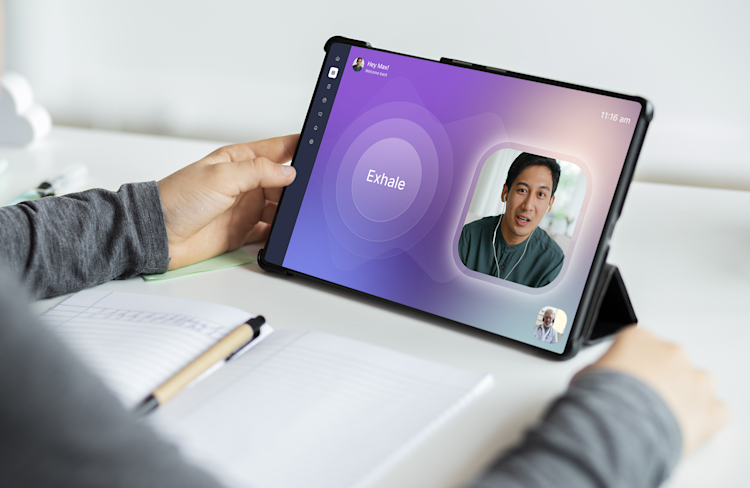5 Telehealth Predictions for 2025
As we near the end of the year, we’re digging into our predictions for Telehealth and virtual care for 2025.

This year has seen many ups and downs for the telehealth industry, with big names like United Health Group and Walmart announcing reductions or shut downs of their Telehealth services. However this doesn’t spell the end for telemedicine, simply a new beginning and a chance for the industry to re-asses, optimize and improve virtual offerings to better suit the needs of patients and practitioners. Kyle Zebley, SVP of public policy for the American Telemedicine Association (ATA) is optimistic; “I don’t think there’s any interest in yanking the US healthcare system back toward the pre-pandemic normalcy in terms of having very limited access to telehealth and virtual care services.”
As we near the end of the year, we’re unpacking some emerging (and continuing) trends in the sector and taking a look at how Telehealth could evolve into 2025.
AI will drastically improve efficiency
Yawn, not another blog post about AI... It might be the buzzword of 2024, but we strongly believe that Artificial Intelligence is set to become a cornerstone of telehealth innovation. The rise in AI technology is impacting all areas of our daily lives, and healthcare is no exception. Specifically for telemedicine, there is huge potential for AI to improve efficiencies and workflows for example by automating routine tasks and analyzing vast amounts of data. AI-driven tools will streamline administrative workflows, from scheduling appointments to managing patient records, to transcribing virtual consultations, reducing the burden on healthcare professionals.
AI algorithms can also assist in diagnostics by quickly analyzing patient data and providing decision support to clinicians. This increased efficiency will allow providers to focus more on patient care and less on administrative tasks, ultimately improving the overall patient experience.
Refinement of remote care models
As telehealth continues to mature and become embedded into patient pathways, there will be increased refinement for when and how remote care is utilized. Not all healthcare services are suitable for virtual delivery, so identifying which types of care work best remotely will be crucial. According to a recent report, 47% of virtual video visits are follow-up appointments, followed by regular check-ups, prescription refills and mental health support.
Patients are increasingly becoming used to receiving certain types of care remotely and often prefer the flexibility and reduced travel times. To that end, 88% of Americans now prefer to use telemedicine (Tech Report). There will always be a need for in-person healthcare such as hands-on procedures and emergency care, and moving forward the industry will continue to refine the circumstances in which telehealth can be beneficial.
Improvements for underserved and remote communities
One of the most promising aspects of telehealth is its potential to bridge the gap in healthcare access for underserved and remote communities. As telehealth technology becomes more advanced and accessible there will be huge benefits for those typically unable to access certain types of care or reach specialists. There is ongoing debate around the future of federal health waivers in the US surrounding telehealth use, with a letter from the The Alliance for Connected Care to the White House stating “The ongoing challenges in accessing mental health and substance use treatment services, particularly in rural and underserved areas, underscores the importance of maintaining these flexibilities”.
Governments and official bodies must support and encourage the further development of virtual care to increase access and care quality. Additionally, further support for example through subsidized technology costs, enhanced internet connectivity and additional training for healthcare professionals can play a pivotal role in reducing healthcare disparities and improving outcomes for marginalized populations.
The WHO and ITU’s recent release of an implementation toolkit for accessible telehealth services highlights a commitment to continued improvement and development of telehealth services globally.
Growth of virtual behavioral health services
The behavioral health sector is poised for significant growth, driven by the expansion of telehealth services. Mental health and counseling services are particularly well-suited for virtual care, allowing patients to receive support from wherever suits them. With 92% of people worldwide believing that mental health is as important or more important than physical health (Wellcome Trust), stigma is slowly reducing and people are more actively seeking behavioural health treatment and preventative support.
Employers and governments are increasingly supporting and encouraging behavioural health care which will only expand the need for easily accessible and convenient digital mental health services. For instance, the NHS recently introduced a new mental health support line making care as accessible as that for physical health. Telehealth platforms will continue to evolve to meet the increasing demand, offering innovative solutions such as virtual therapy sessions, mental health apps, and remote monitoring tools.
Sustainable Growth Through third-party solutions
To achieve long-term success, telehealth providers will increasingly seek out and integrate third-party solutions that support sustainable growth. This includes adopting platforms and technologies that enhance service delivery, data security, and patient engagement. Providers will collaborate with technology partners to implement scalable solutions that address evolving needs and challenges. This can include anything from patient management systems, scheduling tools and video conferencing software. Through seamlessly integrated solutions such as the Whereby video call API, telehealth teams can focus on delivering world-class care experiences, while allowing trusted solutions to do the heavy-lifting for certain areas of the tech stack.
These third-party solutions will help telehealth providers navigate regulatory requirements, ensure interoperability between different systems, and maintain high standards of care. By leveraging external expertise and resources, telehealth providers can focus on delivering high-quality care while driving sustainable growth for their business.
Conclusion
With the telehealth market forecast to reach a value of $286.22 billion by 2030, the future is certainly bright. Through advancements in AI, targeted remote care models, expanded access for underserved communities, and growth in behavioral health services there is incredible opportunity for healthcare platforms to grow rapidly. As telehealth continues to evolve, the focus on efficiency, accessibility, and sustainability will be key drivers of success. By embracing these trends and adapting to the changing landscape, telehealth has the potential to revolutionize healthcare delivery, making it more efficient, inclusive, and patient-centered.


